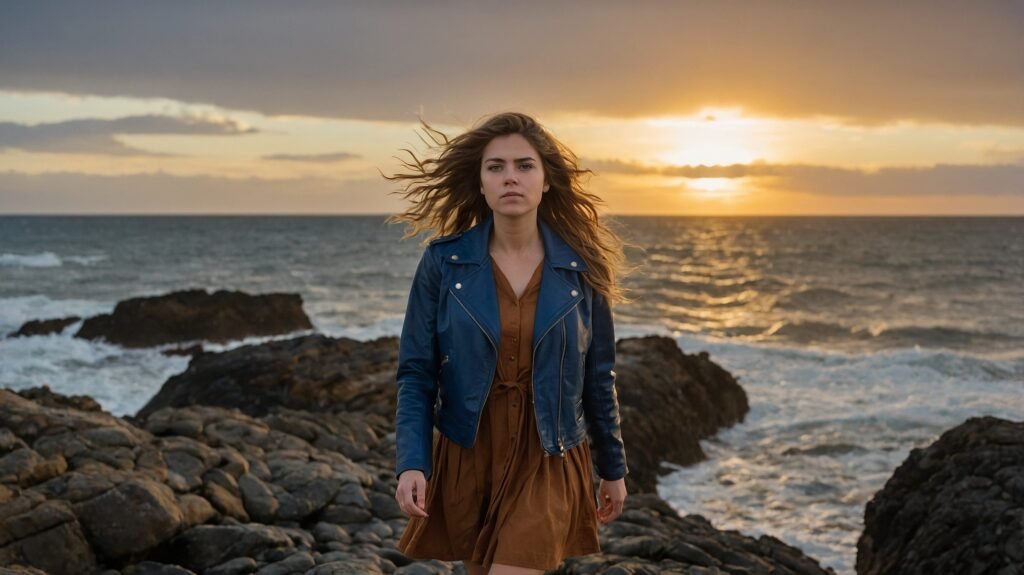Key Takeaways
- Nautical blues and earthy browns were staple colors in clothing during the Age of Exploration.
- These colors reflected the rugged adventures and natural landscapes encountered by explorers.
- Blues represented the vast oceans sailed, while browns symbolized the untamed lands discovered.
- Clothing dyes were often derived from natural sources like indigo plants and tree bark.
- Fashion choices prioritized practicality and durability for long voyages and expeditions.
- The colors conveyed a sense of adventure, bravery, and connection to nature.
- They continue to influence modern fashion with a timeless, rugged aesthetic.
- Blues and browns evoke a romantic nostalgia for the era of great explorations.
During the Age of Exploration, a time when brave souls ventured into uncharted territories and sailed across vast oceans, the world of fashion was defined by two dominant color schemes: nautical blues and earthy browns. These hues served as a reflection of the rugged adventures and natural landscapes encountered by the intrepid explorers of the era.

The Seas and the Lands
The deep, captivating shades of blue that colored the clothing of sailors and explorers paid tribute to the vast, uncharted oceans they bravely navigated. From the rich indigo reminiscent of the high seas to the serene azure evoking coastal waters, these nautical blues symbolized the mysterious ocean depths and endless horizons that awaited adventurous spirits willing to set sail.
The Allure of the Ocean Blues
During this era, the widespread popularity of blue clothing in fashion was closely linked to the practical demands of seafaring life. Garments dyed with natural indigo, a durable plant-based pigment, offered both visual appeal and exceptional longevity. Indigo-dyed fabrics were highly resistant to fading, making them the perfect choice for sailors and maritime workers who faced long journeys and constant exposure to harsh sunlight at sea.
The Earthy Embrace
Balancing the nautical blues, the warm and grounding shades of brown brought depth to the palette, inspired by the rich soils and rugged landscapes that explorers encountered during their overland expeditions. These earthy tones, often created with natural dyes from tree bark and plant roots, evoked a strong connection to the wild, uncharted territories being discovered. The use of natural colors and organic materials highlighted the adventurous spirit and authenticity of exploration.
A Practical Palette
Beyond their symbolic meanings, the blues and browns of the Age of Exploration were chosen for their practical advantages. These colors were less likely to show dirt and wear, ensuring that explorers’ clothing remained presentable during extended journeys through challenging environments.
The Spirit of Adventure
The widespread use of nautical blues and earthy browns in historical fashion was more than just practical—it symbolized the adventurous spirit that defined the Age of Exploration. These popular colors in period clothing represented bravery, resilience, and a profound respect for the natural world, capturing the essence of explorers venturing into unknown lands.
Subsection 2.1: A Timeless Appeal
Even in today’s modern era, the timeless appeal of blues and browns remains strong, evoking a sense of romantic nostalgia for the golden age of exploration. Fashion designers consistently find inspiration in these classic colors, creating contemporary styles that embody the rugged charm and adventurous spirit of past explorers. These enduring hues continue to influence current fashion trends, seamlessly blending tradition with modern design.
Subsection 2.2: Nature’s Influence
The use of natural dyes and the embrace of colors found in the environment further solidified the connection between fashion and the natural world during the Age of Exploration. Clothing became an extension of the landscapes and seascapes that explorers encountered, seamlessly blending with the surroundings.
Subsection 2.3: A Legacy of Boldness
The bold, unapologetic presence of blues and browns in the fashion of the era served as a testament to the fearlessness and determination of the explorers themselves. These colors became symbols of their unwavering spirit and their willingness to venture into the unknown, paving the way for future generations of adventurers and trailblazers.
The Evolution of Color Palettes
- Gradual incorporation of brighter hues from trade and cultural exchange
- Influence of new textile techniques and dye sources
- Shift towards more ornate and embellished clothing as exploration progressed
- Emergence of regional and class-based color preferences
- The impact of colonization and cultural blending on fashion trends

The Enduring Influence
During the Age of Exploration, nautical blues and earthy browns were not mere fashion choices but rather a reflection of the human spirit’s insatiable desire for adventure and discovery. These colors embodied the rugged determination and unwavering courage of the explorers who dared to sail uncharted waters and venture into untamed lands.
As the world became smaller and more interconnected, the fashion landscape evolved, incorporating new hues and styles from diverse cultures and trade routes. However, the lasting legacy of the Age of Exploration can still be witnessed in the timeless appeal of blues and browns, hues that continue to captivate and inspire generations of fashion enthusiasts.
Subsection 5.1: The Allure of the Unknown
Even in the modern age, the allure of the unknown persists, and the colors that once symbolized the spirit of exploration now evoke a sense of wanderlust and adventure. Fashion designers and trendsetters alike draw inspiration from this enduring fascination, creating collections that pay homage to the bold spirit of the explorers of old.
Subsection 5.2: Rugged Elegance
The rugged elegance of nautical blues and earthy browns has transcended time, becoming a staple in contemporary fashion. From denim and khakis to sophisticated evening wear, these colors offer a versatile and timeless aesthetic that appeals to those seeking a balance between practicality and style.
Subsection 5.3: Nature’s Palette
As the world becomes increasingly conscious of environmental issues, the use of natural dyes and eco-friendly production methods has gained renewed appreciation. The Age of Exploration’s embrace of nature’s palette serves as a reminder of the intrinsic beauty and sustainability that can be found in the world around us.
The Symbolism of Color
- Symbolic meanings associated with different shades of blue and brown
- Cultural and historical significance of specific hues
- The role of color in conveying status, rank, and social standing
- The evolution of color symbolism through time and across civilizations
- The influence of religion, mythology, and folklore on color associations
The Art of Dyeing
The art of dyeing played a crucial role in the Age of Exploration, as explorers and sailors sought to create long-lasting and vibrant hues for their clothing. Natural dyes were derived from a variety of sources, each with its own unique properties and challenges.
Subsection 7.1: The Indigo Odyssey
Indigo, a deep blue dye derived from various plant species, was a highly coveted commodity during this era. Its rich color and remarkable fastness made it a prized possession for sailors and explorers, ensuring their clothing maintained its vibrancy even after enduring the harshest of conditions.
Subsection 7.2: The Earthy Palette
Earthy browns were often obtained from natural sources such as tree bark, roots, and nuts. These dyes not only provided a practical and durable color for clothing but also held cultural significance, connecting the wearer to the land and its resources.
Subsection 7.3: The Secrets of Mordanting
The process of dyeing during the Age of Exploration was not without its complexities. Mordants, or chemical compounds, were used to bind the dyes to the fibers, ensuring lasting color and preventing fading. The mastery of mordanting techniques was a closely guarded secret, passed down from generation to generation.

The Fusion of Cultures
As explorers ventured into new lands and encountered diverse cultures, the world of fashion experienced a fusion of styles and colors. The exchange of ideas, techniques, and materials led to the creation of unique and vibrant color palettes that reflected the blending of traditions.
Subsection 8.1: The Spice Trade Route
The spice trade routes not only brought exotic spices to Europe but also introduced new dye sources and textile techniques. Vibrant reds, yellows, and oranges found their way into the fashion of the time, adding warmth and vibrancy to the once-dominant blues and browns.
Subsection 8.2: The Silk Road
The legendary Silk Road, a network of trade routes connecting the East and West, facilitated the exchange of precious silks and intricate embroidery techniques. These luxurious fabrics and embellishments added a touch of opulence to the clothing of the wealthy and powerful, blending the rugged aesthetics of exploration with the refinement of distant lands.
Subsection 8.3: The Indigenous Influence
As explorers encountered indigenous cultures, they were exposed to new methods of dyeing and color extraction. These ancient techniques, often rooted in deep cultural traditions and spiritual beliefs, left an indelible mark on the fashion of the era, resulting in unique and captivating color combinations.
The Colors of Nobility
- The association of specific colors with royalty and nobility
- The use of color as a symbol of status and wealth
- The influence of heraldry and coats of arms on color choices
- The role of sumptuary laws in regulating the use of certain colors
- The impact of royal patronage on the development of dye industries
The Nautical Wardrobe
The clothing worn by sailors and explorers during the Age of Exploration was a reflection of both practicality and style. From the iconic blue and white striped shirts to the rugged leather boots, each garment served a purpose while embracing the color schemes that defined the era.
Subsection 10.1: The Mariner’s Uniform
Nautical blues were a prominent feature in the uniforms of sailors and naval officers. These colors not only provided a practical advantage at sea but also instilled a sense of pride and unity among the crew. The deep indigo hues were often complemented by crisp whites, creating a timeless and iconic look.
Subsection 10.2: Weathered and Worn
The clothing worn by explorers and adventurers bore the marks of their journeys, with earthy browns and faded blues reflecting the hardships endured and the landscapes traversed. These weathered hues became a badge of honor, a testament to the resilience and determination of those who dared to venture into the unknown.
Subsection 10.3: Functional Fashion
From sturdy canvas trousers to heavy wool coats, the fashion choices of the era prioritized functionality over frivolity. Garments were designed to withstand the elements, protect against the sun and wind, and allow for unrestricted movement during arduous expeditions.

The Art of Textile Printing
While the Age of Exploration was defined by the bold presence of solid blues and browns, the art of textile printing introduced intricate patterns and designs to the fashion landscape. From traditional woodblock printing techniques to the innovative use of natural dyes, textiles became canvases for artistic expression.
The introduction of new printing methods and the exchange of cultural influences led to the creation of captivating patterns that blended the aesthetics of different civilizations. Floral motifs, geometric shapes, and intricate paisley designs adorned fabrics, adding depth and visual interest to the dominant color schemes of the era.
As trade routes expanded and cultural exchange flourished, the art of textile printing evolved, incorporating new techniques and motifs from distant lands. The fusion of styles and the merging of cultural narratives resulted in textiles that told stories of exploration, adventure, and the interconnectedness of the world.
Subsection 12.1: The Woodblock Wonders
Woodblock printing, an ancient technique that originated in Asia, found its way into the textile arts of the Age of Exploration. Intricate designs were meticulously carved into wooden blocks and then printed onto fabrics using natural dyes, creating striking patterns that adorned the clothing of the wealthy and powerful.
Subsection 12.2: The Batik Brilliance
The Indonesian art of batik, a wax-resist dyeing technique, captivated the imagination of explorers and traders alike. The vibrant colors and intricate patterns of batik textiles became sought-after commodities, influencing fashion trends and inspiring new ways of adorning clothing with intricate designs.
Subsection 12.3: The Paisley Pandemonium
The iconic paisley pattern, with its intricate swirls and teardrop shapes, found its origins in the Persian empire and gained widespread popularity during the Age of Exploration. This motif graced the fabrics of the wealthy and aristocratic, embodying the exoticism and cultural exchange that defined the era.
The Impact of Trade and Travel
- The influence of trade routes on the availability of dyes and textiles
- The exchange of fashion trends and styles between different cultures
- The role of explorers and merchants in introducing new colors and materials
- The impact of colonization on the fashion industry and textile production
- The emergence of global fashion trends and the blending of cultural aesthetics
The Practical Considerations
While fashion during the Age of Exploration was heavily influenced by symbolic meanings and cultural exchanges, practical considerations also played a significant role in determining the colors and materials used in clothing. Explorers and sailors faced harsh conditions and rigorous physical demands, necessitating garments that were durable, functional, and well-suited for their adventures.
Subsection 14.1: Weatherproofing and Protection
The nautical blues and earthy browns that dominated the era were not only aesthetically pleasing but also offered practical advantages in terms of weatherproofing and protection. Fabrics like wool and canvas, dyed in these hues, provided insulation against the elements and resistance to fading from exposure to sun and saltwater.
Subsection 14.2: Ease of Movement
The clothing worn by explorers and sailors had to allow for unrestricted movement, enabling them to navigate challenging terrains and perform strenuous tasks with ease. Loose-fitting trousers, lightweight shirts, and flexible footwear were designed with agility and comfort in mind, ensuring that fashion did not hinder the spirit of adventure.
Subsection 14.3: Durability and Longevity
Embarking on long voyages and expeditions meant that clothing had to withstand the test of time and endure the rigors of travel. The use of natural dyes and sturdy fabrics ensured that garments retained their color and integrity, even after months or years of wear and exposure to the elements.

Summary Table
| Color Scheme | Symbolic Meaning | Practical Advantages | Cultural Influences |
|---|---|---|---|
| Nautical Blues | Vast oceans, adventure, bravery | Durable, weatherproof, fade-resistant | Indigo dye trade, naval uniforms |
| Earthy Browns | Untamed lands, ruggedness, nature | Camouflage, warmth, longevity | Indigenous dyeing techniques, natural dyes |
Conclusion
The Age of Exploration was a time of great discovery, where the boundaries of the known world were pushed and the human spirit soared to new heights. The fashion of this era, dominated by nautical blues and earthy browns, was not merely a reflection of the colors found in nature but a vivid tapestry woven with stories of adventure, cultural exchange, and the indomitable spirit of the explorers themselves.
These hues, once the practical choices of sailors and adventurers, have transcended time and continue to captivate us with their timeless appeal and rich symbolism. They serve as a reminder of the human capacity for courage, resilience, and an insatiable thirst for the unknown.
As we navigate the ever-changing landscapes of fashion, let us embrace the enduring legacy of the Age of Exploration and allow the blues and browns to transport us to a time when the world was vast and unexplored, when the call of the ocean and the lure of untamed lands beckoned the bold and the daring to embark on journeys that would shape the course of history.

Frequently Asked Questions
What was the significance of blue and brown colors in the Age of Exploration?
Blue and brown colors held great significance during the Age of Exploration. Blues represented the vast oceans that explorers sailed, while browns symbolized the untamed lands they discovered. These colors reflected the rugged adventures and natural landscapes encountered during this era.
Why were natural dyes used for clothing during this time?
Natural dyes were used for clothing during the Age of Exploration due to their availability and practicality. Dyes derived from plants, such as indigo and tree bark, provided durable colors that could withstand the harsh conditions of long voyages and expeditions.
How did the spice trade influence fashion during the Age of Exploration?
The spice trade routes not only brought exotic spices to Europe but also introduced new dye sources and textile techniques from other cultures. This led to the incorporation of vibrant reds, yellows, and oranges into the fashion of the time, adding warmth and vibrancy to the dominant blues and browns.
What was the significance of sailors’ uniforms during this era?
Sailors’ uniforms played a crucial role in fostering a sense of unity and pride among crews. The deep indigo blues and crisp whites of these uniforms became iconic, representing the spirit of adventure and the practical needs of seafaring life.

How did indigenous cultures influence the fashion of the Age of Exploration?
As explorers encountered indigenous cultures, they were exposed to new methods of dyeing and color extraction, often rooted in deep cultural traditions and spiritual beliefs. These ancient techniques left an indelible mark on the fashion of the era, resulting in unique and captivating color combinations.
Why were earthy browns popular in explorers’ clothing?
Earthy browns were popular in explorers’ clothing due to their practical advantages. These warm, grounding tones derived from natural dyes like tree bark and plant roots provided camouflage, warmth, and longevity, making them well-suited for overland expeditions through rugged terrains.

Brenda Tillman is a color maestro who brings artistic brilliance to every piece she crafts. Passionate about imaginative expressions, she illuminates the world of fashion with her expert guidance on shades and combinations. Beyond her writings, Brenda is a culinary enthusiast and a global traveler, infusing her work with diverse insights. Her unique touch transforms simple color choices into art.
Reviewed By: Joanna Perez and Anna West
Edited By: Lenny Terra
Fact Checked By: Matthew Mansour
Photos Taken or Curated By: Matthew Mansour
